Three More Houses Demolished In Gaza
By Eva Bartlett
01 March, 2010
Ingaza Blog
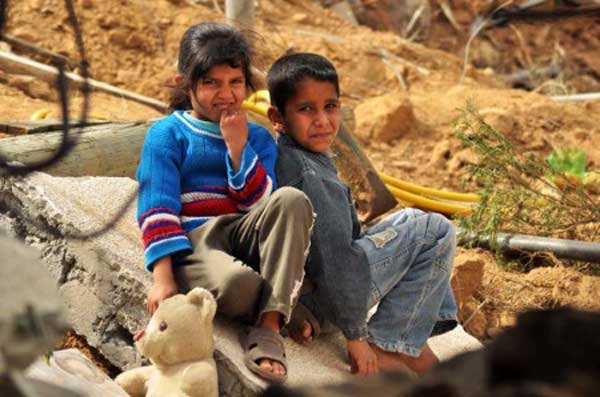
Three days ago when I saw these children, their father bragged: “she gets near perfect grades; she got a prize in school today for her grades. And he’s a whiz.”
We were walking around the ruins of his home, to the east of central Gaza’s al-Musaddar village, touring the wreckage of his life.
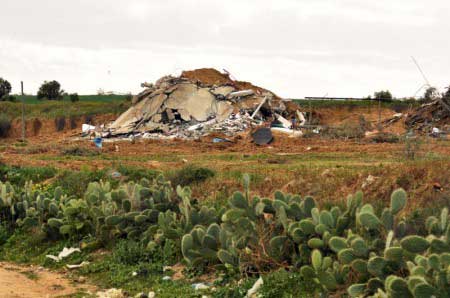
Israeli bulldozers had come in a week prior and destroyed his house and livelihood, and those of 2 other neighbouring families, tearing down 3 houses in total and 17 dunams of treed land.
Without reason.
It’s a lush area, next to a wadi (valley, though the water has long since stopped streaming through, cut off, most say, on the Israeli side before it flows seaward through Gaza). Trees thrive along the road and thrived on the bulldozed, fertile land. The air fresh with moisture, promising rain. What wheat remains is already tall for the season.
Salem Suleiman Awad Abu Said (born 1943), lies on a blanket near the ruins, exhaustion written on his face.
“I was expelled from my family’s land in Beerseba in 1948,” he recalls. “Now our house is destroyed and we have nothing, again,” he says, returning to look inside the ruins of his home.
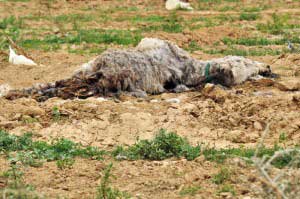
A dead donkey lies strewn some metres from the razed hut he’d sheltered the night in, caught by the massive Israeli military bulldozers.
Of the three collectively-punished families, Abdel Hai Abu Said’s is the luckiest, although in addition to his house he lost 5 dunams of olive and date trees, and the 150 pigeons he bred. His brother Moeen, 100 metres further from the border, lost his house, his olive and fruit trees, his 1000 bird chicken farm, and his gratitude at having completed an 8 year in the making home.
“We lived in it for just one month before it was demolished,” he says.
The house is only a puddle of concrete, utterly unihabitable.
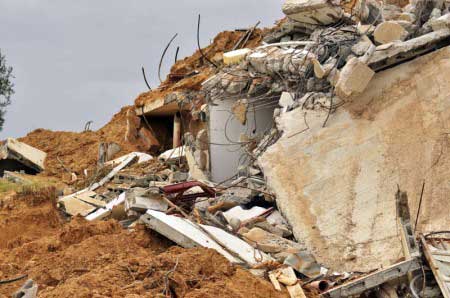
By most standards, Abdel Hai’s home is not habitable… yet in one room with 45 degree angle walls (or vacant spaces where the walls were, bullet-riddled, cracked remainders of walls overlooking the border from where the bulldozers streamed) the family of 10 crowds nightly to take cover from the cold and rain. There is a scant blanket on the floor, a plastic bag containing the salvaged clothes (what doesn’t lie beneath the heap of rubble), and another plastic bag with pieces of bread in it. Otherwise it is rubble, chaos, and liable to collapse at any point.
Aouni Abu Said, brother of the homeless Moeen and Abdel Hai, escaped the worst ravages of the reported 5 bulldozers, 10 tanks and 70 foot soldiers.
“My wife was in the kitchen with some of our children when the Israelis came shooting. Look, see the bullet holes here… and here… and here…” he says, touring from stippled kitchen to children’s bedroom to baby’s bedroom, the latter’s walls a lattice work of fat bullet holes. “This is our baby’s room!” he repeats, smiling a gracious smile that never once leaves his face.
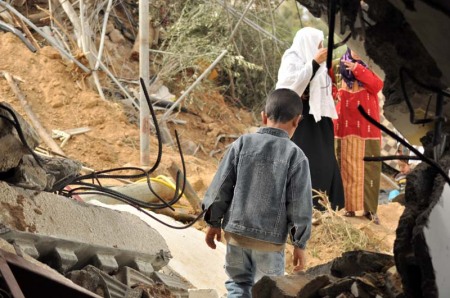
Roughly 150 metres north, Radia Abu Sbaih and her sister and niece tramp over the stubs of hundreds of olive and fruit trees, past the water cistern with tree corpses clogging it, and to the heap of concrete and personal possessions that demarks their home.
Her anguish is focussed on the land, the trees.
“Most of our trees were over 40 years old, some over 70 years. And the kharooba tree was well over 100 years old,” she says of a tree particular to the region.
“We had it all: olive, guava, mango, pomegranate, date,…” she rattles of the trees, pausing to force ripe guavas on us. Radia speaks of how they lived off the land, growing a variety of vegetables including and exceeding spinach, beans, onions, tomatoes, cucumbers, garlic, peppers, lettuce…She reminisces on harvesting olives and explains how to pickle them or press them into oil, returning again to the theme of the importance of locally grown food.

The breeze, before the rains, carries fertility; one can imagine how verdant the land was, clouded with branches and rustling leaves. Those border-region birds pipe their special bird call, and further off birds of prey ride the wind in circles. One can imagine the life which once abounded here, everywhere along the border, before the bulldozers.
Another F-16 Israeli warplane thunders over, low and intrusively loud.
“They’re always over us,” Radia says.
The zananas (drones), too, pollute the skies, a train wreck of disharmony.
“But you know, we didn’t have any problems during the war,” she says, referring to the Israeli massacre of winter 2008-2009. “Not a single problem, they went right past us.”
She reiterates that the area is quiet, they’ve lived and worked without fear though the home is 700 metres from the border.
“Far, it’s far,” she says, recalling how she and her sister tended the trees daily.
“We heard them coming and saw the tanks through the trees. We ran away immediately,” she says of the morning of 18 February.
We move from the edge of a low cliff over-looking a small valley, into which bodies and limbs of their trees have been bulldozed.
We walk along bulldozer treads, deeply imprinted in the land, a lasting reminder of the Israeli military presence…if the tree stumps weren’t reminder enough.
Past the destroyed cistern, past the former vegetable patch where a solidarity green onion lies withering, and to the heap of their home again.
Radia, stoic and poised, loses it, yells into the wind about their losses and the culpability of the world in ignoring Israel’s countless crimes against Palestinians.
“Twenty people lived off this land! Our water is gone, our house is gone, we have no electricity, we have no shelter. When it rains we have no where to go. Look, everything is ruined, everything is buried underneath the rubble.”
She picks up objects, displaying them, tossing them with disgust back on the heap: a tv, a gas range, a bottle of olives, another of olive oil (both from their trees, of course), a fan, kitchen items, clothing. She grabs a sweater sleeve and tugs, to no avail: it’s locked beneath the ruins.
Our eyes move from rubble to destroyed drinking water well to the surviving donkey, alhamdillah, whose cart is destroyed, smashed into crumpled pieces. Even that cart alone will cost roughly $500 to replace, she says.
“The well was destroyed; it was a drinking water source. The donkey cart is destroyed. Now I have to walk one hour each way, every day, to bring jugs of water for drinking,” Radia says.
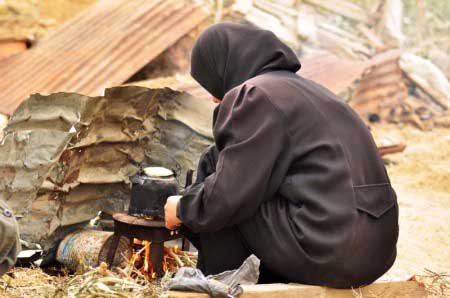
Radia’s niece sits by a makeshift fire pit, lights the limbs of felled trees, and heats precious water for tea for their guests. From a smudged plastic screw-top container she takes a packet of tea and another of sugar, neatly replacing them when finished. A tiny semblance of order in their world turned upside down. The situation strikes me: the trees that they loved so dearly, killed by Israeli bulldozers, now provide the heat they need when everything has been destroyed.
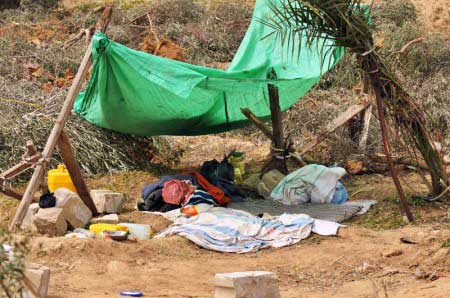
Radia repeats what her neighbours have said: there were no problems in the area, the military invasion was completely unexpected and they can’t think of any reason, save spite, for Israel’s destruction of their land and livelihoods.
As we drink tea, it begins to rain.


